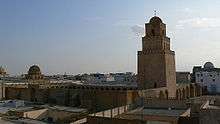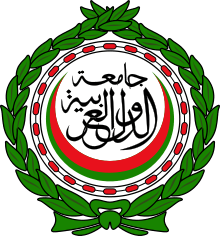Demographics of the Arab League
| Part of a series on | ||||||||
| Arab League | ||||||||
|---|---|---|---|---|---|---|---|---|
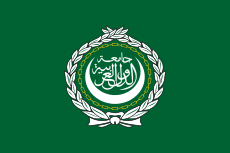 | ||||||||
|
Issues
|
||||||||
|
||||||||
|
||||||||
|
|
||||||||
|
||||||||
The Arab League (League of Arab States) is a social, cultural and economic grouping of 22 Arab states in the Arab world. As of January 1, 2007, the combined population of all the Arab states was around 340 million people.
The most populous Arab League member state is Egypt, with a population of 80 million residents. Djibouti is the least populated, with around 500,000 inhabitants. Most of the Arab states of the Persian Gulf import high amounts of foreign labour. For example, the United Arab Emirates' native inhabitants make up less than 20% of its overall population.
Population growth
The population of the Arab League as estimated by the CIA in July, 2014 was around 357,000,000. No exact figures of the League's annual population growth, fertility rate, or mortality rate are known to exist.
Most of the Arab League's population is concentrated in and around major urban areas.[1]
Muhammad's Islamic Ummah, Christianity and Judaism were all reportedly founded in or near areas that are now Arab League countries. Consequently, the majority of the Arab League's citizens are either Muslims, Christians or Jews. The countries of the Arab League host several holy cities and other religiously significant locations, including Alexandria, Mecca, Medina, Kirkuk, Arbil, and Baghdad. Sunni Muslims constitute the majority of the Arab League's residents. However, large numbers of Shi'a Muslims make up the majority in areas of Lebanon, Iraq, and Bahrain.
Christianity is the second largest religion in the League, with over 20 million Christians living in countries such as Lebanon, Egypt, Iraq, Bahrain, Syria, Kuwait and Jordan. There are smaller Jewish populations living mainly in the western part of the Arab league. Places such as Bahrain, Morocco, Algeria, Yemen, Tunisia, Syria, Egypt and Iraq all have Jewish populations. However, most Arab Jews emigrated from the Arab states to Israel after its founding in 1948.[2] Other minor religions such as Druze religion, the Bahá'í Faith, Mandeanism, Yazdanism, Zoroastrianism, Shabak religion and Yarsan are practiced on a much smaller scale.
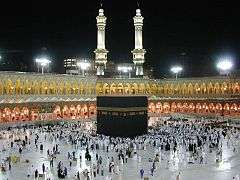
- Muslim population - 311,093,951
- Total population - 349,870,608
Religious percentages of the Arab League
| N | Country | Muslims | Christians | Others |
|---|---|---|---|---|
| _ | |
90% | 6% | 4% |
| 1 | |
98% | 1% | 1% |
| 2 | |
70% | 15%[3] | 15% |
| 3 | |
99% | 1% | n/a |
| 4 | |
94% | 6% | n/a |
| 5 | |
94% | 5% | 1% |
| 6 | |
95% | 4.3% | 0.7% |
| 7 | |
92% | 6% | 2% |
| 8 | |
85% | 7% | 8% |
| 9 | |
54% | 41% | 5% |
| 10 | |
97% | 2.4% | 0.6% |
| 11 | |
99% | 0% | 0% |
| 12 | |
98.7% | 1.1% | 0.2% |
| 13 | |
92.5% | 5% | 2.5% |
| 14 | |
77.9% | 8.5% | 10% |
| 15 | |
90% | 9.8% | 0.2 |
| 16 | |
97% | 1.3% | 1.7% |
| 17 | |
99% | 0% | 0% |
| 18 | |
97%[4] | 3% | |
| 19 | |
87% | 10% | 3% |
| 20 | |
98% | 1% | 1% |
| 21 | |
76% | 9.0% | 15% |
| 22 | |
99% | 0% | 0% |
Language
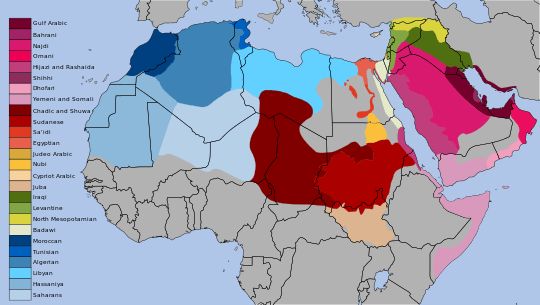
Arabic is the Arab League's official language, but additional languages are often used in the daily lives of some of the League's citizens. Currently, three major languages other than Arabic are used widely: Kurdish in northern Iraq and parts of Syria, Berber in North Africa, and Somali in the Horn of Africa.
There are several minority languages that are still spoken today, such as Afar, Armenian, Hebrew, Nubian, Persian, Aramaic, Mandic, Syriac, and Turkmen. Arabic is a non-native language to 20% of the Arab League's population, with the Somali, Berber and Kurdish languages considered the most widely used after Arabic.
On the other hand, Arabic is divided into over 27 dialects. Almost every Arab state has at least one local dialect of its own. they can be divided into 5 major branches, the Peninsula Arabic, which is the Arabic used in the Arabian peninsula, with around 9 main dialects, Arabic of the Nile Valley, which includes the Masri, Saedi, Sudanese and Chadic Arabic, the Arabic of the Fertile Crescent, which includes the Bedawi, Levant Arabic, Iraqi Arabic and North Mesopotamian Arabic, the Magharbi Arabic, which includes the Dialects used in Mauritania, Morocco, Libya, Algeria and Tunisia, also another category of Arabic is the other isolated dialects of Arabic, like the Judeo-Arabic, Mediterranean Arabic, Nubi Arabic, and the juba Arabic, which have greatly been affected by these communities' own pronunciation, culture and native tongue.
Arab League populations
According to the League of Arab States, the Arab League is an organization of independent Arab States in North and Northeast Africa and Southwest Asia.[5] Member nations are in turn bound by the Charter of the Arab League.[6]
Many Arab countries in the Persian Gulf have sizable (10–30%) non-Arab populations. Iraq, Bahrain, Kuwait, Qatar, United Arab Emirates and Oman have a Persian speaking minority. The same countries also have Hindi-Urdu speakers and Filipinos as sizable minority. Balochi speakers are a good size minority in Oman. Additionally, countries like Bahrain, UAE, Oman and Kuwait have significant non-Arab and non-Muslim minorities (10–20%) like Hindus and Christians from India, Pakistan, Bangladesh, Nepal and the Philippines.
Many non-Arab countries bordering the Arab states have large Arab populations, such as in Chad, Israel, Mali, Niger, Senegal and Turkey.
The table below shows the distribution of populations in the Arab world and Israel, as well as the official language(s) within the various Arab states.
| Country | Population | Official language(s) | Notes |
|---|---|---|---|
| | 38,700,000[7] | Arabic co-official language with Berber | |
| | 1,314,089[8] | Arabic official language | |
| | 766,865[9] | Arabic co-official language with Comorian and French | |
| | 810,179[10] | Arabic co-official language with French | |
| | 86,895,099[11] | Arabic official language | |
| | 32,585,692[12] | Arabic co-official language with Kurdish | |
| | 7,930,491[13] | Arabic official language | |
| | 4,156,306[14] | Arabic official language | 60% of Kuwait's population is Arab (including Kuwaitis and Arab expatriates). |
| | 5,882,562[15] | Arabic official language | |
| | 6,244,174[16] | Arabic official language | |
| | 3,516,806[17] | Arabic official language | |
| | 32,987,206[18] | Arabic co-official language with Berber | |
| | 3,219,775[19] | Arabic official language | |
| | 4,225,710 | Arabic official language | Gaza Strip: 1,763,387, 100% Palestinian Arab,[20] West Bank: 2,676,740, 83% Palestinian Arab and other[21] |
| | 2,123,160[22] | Arabic official language | |
| | 27,345,986[23] | Arabic official language | |
| | 10,428,043[24] | Arabic co-official language with Somali | |
| | 35,482,233[25] | Arabic co-official language with English | |
| | 17,951,639[26] | Arabic official language | |
| | 10,937,521[27] | Arabic official language | |
| | 8,264,070[28] | Arabic official language | |
| | 26,052,966[29] | Arabic official language |
Armenians

The Arab world has between 400,000 and 500,000 Armenians inhabiting its geographical area. Armenians are largely concentrated in countries such as Lebanon 150,000 - 250,000 and Syria 100,000 to 150,000 and to a lesser degree Egypt and Iraq, but Armenians can also be found in countries like Qatar and the UAE. These Armenians are economic migrants from Lebanon and Syria.
Most Armenians are Christians mainly following the Orthodox Armenian Apostolic Church. The church has one of its two headquarters in Antelias, Lebanon, called The Catholicosate of the Great House of Cilicia (the other being in Armenia called Mother See of Holy Etchmiadzin). There are also Armenian Catholics. The world headquarters of the Armenian Catholic Church is also located in Beirut, Lebanon (and historically in Bzoummar, Lebanon). There are also a minority Armenian Evangelical Protestants. The Middle East headquarters of the Armenian Evangelical Church is in Beirut called Union of the Armenian Evangelical Churches in the Near East.
Assyrians
Assyrians (also known as Chaldo-Assyrians) can be found in Iraq, north eastern Syria, and to a lesser degree north western Iran and south eastern Turkey. They are an ancient Semitic people who retain Aramaic as a spoken language. They are exclusively Christian and are descendants of the ancient pre Arab Assyrians/Mesopotamians. Almost all Christians in Iraq are ethnic Assyrians, where they number approximately 800,000. Numbers in Syria are harder to identify, because they are often included in with the general Christian population, however the Christians of the Tur Abdin and Al Hasakah regions in the north east are predominantly Assyrians.
Berbers
.jpg)
Berbers are an ethnic group indigenous to North Africa. They are distributed in an area stretching from the Atlantic Ocean to the Siwa Oasis in Egypt, and from the Mediterranean Sea to the Niger River. Historically, they spoke Berber languages, which together form the Berber branch of the Afro-Asiatic family. Since the Muslim conquest of North Africa in the seventh century, a large number of Berbers inhabiting the Maghreb have acquired different degrees of knowledge of varieties of Maghrebi Arabic.
Circassians
Circassians are a people who originate in the North Caucasus. They are predominantly Muslim, and can be found in Iraq, Syria, Jordan, Israel and Lebanon in relatively small numbers.
Copts
Egyptian Copts are an ethno-religious group who do not identify themselves as Arab. They place heavy emphasis on the Egyptian aspect of their identity and their Christian heritage. Their numbers are heavily disputed but are estimated to compromise roughly 10% of the Egyptian population. They are mainly followers of the Coptic Orthodox Church of Alexandria, there are however a minority among them who are members of the Coptic Catholic Church, and an even smaller group who belong to the Coptic Evangelical Church. The Coptic language, which directly descends from the Egyptian spoken in ancient Egypt, continues to be used as the liturgical language of the Coptic Orthodox Church of Alexandria.
Jews
Many Jews in Israel have roots in Arab countries (Sephardi Jews and Mizrahi Jews), from where most fled in the first decades following the creation of Israel and the 1948 Arab-Israeli War. Tiny Jewish minorities exist still in Lebanon, Tunisia and Morocco.
Kurds
In the northern regions of Iraq (15-20%) and Syria (10%) live the Kurds, an Indo-European ethnic group who speak Kurdish, a language closely related to Persian and using Persian alphabet (In Turkey, Kurds use Latin alphabet). The majority of Kurds are Sunni Muslim, others are Alevi Muslim, with Christian and Yarsan minorities. The nationalist aspiration for self-rule or for a state of Kurdistan has created conflict between Kurdish minorities and their governments in Iraq, Iran (20-28%), Syria and Turkey (25-30%).
Mandaeans
Mandaeans, sometimes also called Sabians, are a people found mainly in southern Iraq. Their numbers total no more than 70,000. They follow Mandaeism, a gnostic religion.
Maronites
A large proportion of Lebanese Maronite Christians identify with a pre-Arab and pre-Islamic Phoenician identity, and many do not self identify as ethnic Arabs. Maronites, part of the Maronite Church, an Oriental Catholic Syriac Church live mainly in Lebanon where they retain, by tradition and National Pact, the post of Presidency of the Republic and the leadership of the Lebanese Army. They also have great presence in Syria and live in smaller numbers in Palestine, Jordan and Egypt.
Mhallami
Mhallami are a tiny minority of the Assyrian/Syriac people who have converted to Islam but retained their Syriac culture.
Nubians
Nubians, found in Northern Sudan and Southern Egypt, are a different ethnicity from their northern and southern neighbors in Egypt and Sudan, numbering 1.7 million in Sudan and Egypt. The Nubian people in Sudan inhabit the region between Wadi Halfa in the north and Aldaba in the south. The main Nubian groups from north to south are the Halfaweyen, Sikut (Sickkout), Mahas, and Danagla. They speak different dialects of the Nubian language.
Ancient Nubians were famous for their vast wealth, their trade between Central Africa and the lower Nile valley civilizations, including Egypt, their skill and precision with the bow, their 23-letter alphabet, the use of deadly poison on the heads of their arrows, their great military, their advanced civilization, and their century-long rule over the united upper and lower Egyptian kingdoms.
Roma
Roma are to be found in many parts of the Middle East and North Africa; their numbers are unknown. They speak their own language and may loosely follow the predominant religion of the country they live in.[30]
Shabaks
Shabaks are mainly found in Iraq, they are either Muslim or follow native religions. They are also related to Kurds, but like the Yazidi, emphasise their separate identity.
Somalis
Somali and Arabic are the two official languages in Somalia, both of which belong to the Afro-Asiatic family. Article 3 of the constitution outlines the country's founding principles, establishing it as a Muslim state, and a member of the Arab and African nations.[31] About 85% of local residents are ethnic Somalis,[32] who have historically inhabited the northern part of the country.[33] Many self-identify as Somali instead of Arab despite centuries-old ties to Arabia.[34] There are also a number of Benadiris, Bravanese, Bantus, Bajunis, Ethiopians, Indians, Pakistanis, Persians, Britons and Italians.[33][35]
Djibouti, whose demographics are approximately 60% Somali and 35% Afar, is in a similar position. Arabic is one of the official languages, 94% of the nation's population is Muslim, and its location on the Red Sea places it in close proximity to the Arabian Peninsula. Somali and Afar are also recognized national languages.[36]
Turkmen and Turks
The Arab world is also home to sizeable populations of Turkmen, such as Iraqi Turkmen. These are related to the Azeri people of Iran. The vast majority of Turkmen are secular Muslim, but there are a small number of Christians also. They live predominantly in Northern Iraq, but in smaller numbers in Syria and Lebanon.
The Turks colonized many Arab countries during the rule of the Ottoman Empire; today there are Turkish minorities living in Algeria (Algerian Turks), Egypt (Egyptian Turks), Jordan (Jordan Turks), Lebanon (Lebanese Turks), Syria (Syrian Turks), Tunisia (Tunisian Turks), and Yemen (Yemeni Turks).
Yazidi
The Yazidi are a religious Kurdish community who represent an ancient religion that is linked to Zoroastrianism and Sufism. They number 500,000 in Iraq and 14,000 in Syria.
Modern identities
Egyptians

Egyptians generally do not identify themselves as ethnic Arabs, with the word "Arab" in Egypt often being used to refer to Bedouins or Gulf Arabs.[37] Numerous cultural traditions that predate the Muslim conquest of Egypt distinguish Egyptian culture from that of other Arab states.[38] The Egyptian people acknowledge their pre-Arab identity and Egyptian nationalism has become the dominant ideology in Egypt after the death of former president Gamal Abdel Nasser who was a staunch advocate for Arab nationalism and was considered the leader of the Arab nationalist movement during his rule. His successor Anwar Sadat embarked on a path to revive the nationalist ideas that preceded the pan-Arabist movement in Egypt by asserting that only Egypt and Egyptians were his responsibility.[39] These views and sources for collective identification in Egypt are captured in the words of a linguistic anthropologist who conducted fieldwork in Cairo:
| “ | Historically, Egyptians have considered themselves as distinct from 'Arabs' and even at present rarely do they make that identification in casual contexts; il-'arab [the Arabs] as used by Egyptians refers mainly to the inhabitants of the Gulf states... Egypt has been both a leader of pan-Arabism and a site of intense resentment towards that ideology. Egyptians had to be made, often forcefully, into "Arabs" [during the Nasser era] because they did not historically identify themselves as such. Egypt was self-consciously a nation not only before pan-Arabism but also before becoming a colony of the British Empire. Its territorial continuity since ancient times, its unique history as exemplified in its pharaonic past and later on its Coptic language and culture, had already made Egypt into a nation for centuries. Egyptians saw themselves, their history, culture and language as specifically Egyptian and not "Arab."[40] | ” |
Lebanese
North Africans
North Africans are the inhabitants of the North Africa (Morocco, Algeria, Tunisia, Libya and Mauritania). They mostly speak Maghrebi Arabic, which is descended from Classical Arabic and has a marked Berber substratum.
In 647 AD (the year 27 of the Hegira), the first Muslim expedition to Africa took place. By 700 AD, the area had been conquered and converted to the Islamic faith. We know little of the early Islamic town, but by the tenth century the area outside of the fortress was once more filled with houses: on the site of the Roman baths over twelve of these were excavated, with large courtyards surrounded by long, thin, rooms.[41]
After conquering Cairo, the Fatimids abandoned Tunisia and parts of eastern Algeria to the local Zirids (972–1148).[42] The invasion of Ifriqiya by the Banu Hilal, a warlike Arab tribes encouraged by the Fatimids of Egypt to seize North Africa, sent the region's urban and economic life into further decline.[42]
Similar to an army of locusts, they destroy everything in their path.
Genetics
Y-Chromosome
Listed here are the human Y-chromosome DNA haplogroups in main regions of the Arab world (Maghreb, Mashriq and Arabian peninsula).[44]
| Haplogroup | n | A | B | C | DE | E1a | E1b1a | E1b1b1 | E1b1b1a | E1b1b1a1 | E1b1b1a1b | E1b1b1a2 | E1b1b1a3 | E1b1b1a4 | E1b1b1b | E1b1b1c | F | G | H | I | J1 | J2 | K | L | N | O | P,R | Q | R1a1 | R1b | R1b1a | R1b1b | R2 | T |
| Marker | M33 | M2 | M35 | M78 | V12 | V32 | V13 | V22 | V65 | M81 | M34 | M89 | M201 | M69 | M343 | V88 | M269 | M70 | ||||||||||||||||
| Maghreb | ||||||||||||||||||||||||||||||||||
| Sahara/Mauritania | 189 | - | 0.53 | - | - | 5.29 | 6.88 | - | - | - | - | - | - | - | 55.56 | 11.11 | - | - | - | - | 13.23 | - | - | - | - | - | - | - | - | - | 6.88 | 0.53 | - | - |
| Morocco | 760 | 0.26 | 0.66 | - | - | 2.76 | 3.29 | 4.21 | 0.79 | 0.26 | - | 0.26 | 1.84 | 3.68 | 67.37 | 0.66 | 0.26 | 0.66 | - | 0.13 | 6.32 | 1.32 | 0.53 | - | - | - | 0.26 | - | - | - | 0.92 | 3.55 | - | - |
| Algeria | 156 | - | - | - | - | 0.64 | 5.13 | 0.64 | 1.92 | 0.64 | - | 0.64 | 1.28 | 1.92 | 44.23 | 1.28 | 3.85 | - | - | - | 21.79 | 4.49 | 0.64 | - | - | - | - | 0.64 | 0.64 | - | 2.56 | 7.04 | - | - |
| Tunisia | 601 | - | 0.17 | - | - | 0.5 | 0.67 | 1.66 | - | - | - | - | 3 | 3.16 | 62.73 | 1.16 | 2.66 | 0.17 | - | 0.17 | 16.64 | 2.83 | 0.33 | - | - | - | 0.33 | - | 0.5 | - | 1.83 | 0.33 | - | 1.16 |
| Libya | 83 | - | - | - | - | - | 38.55 | - | - | - | - | 2.41 | - | 4.82 | 45.78 | - | - | 8 | - | - | - | - | - | - | - | - | 2.41 | - | - | - | 6.02 | - | - | - |
| Machrik | ||||||||||||||||||||||||||||||||||
| Egypt | 370 | 1.35 | - | - | - | 0.54 | 2.43 | 3.24 | 0.81 | 7.03 | 1.62 | 0.81 | 9.19 | 2.43 | 11.89 | 6.76 | 1.08 | 5.68 | - | 0.54 | 20.81 | 6.75 | 0.27 | 0.81 | - | 0.27 | 0.54 | 0.27 | 2.16 | - | 2.97 | 2.97 | 0.54 | 6.22 |
| Lebanon, Palestine, Jordan, Syria, Iraq | 2741 | 0.18 | 0.04 | 0.04 | - | 0.33 | 0.62 | 0.44 | - | - | - | 1.24 | 8.72 | - | 0.84 | 5.36 | 0.15 | 5.47 | - | 2.84 | 30.83 | 21.05 | 0.69 | 3.43 | 0.15 | 0.07 | 0.66 | 1.2 | 3.39 | 0.36 | 5.47 | 1.97 | 0.47 | 3.98 |
| Arabian Peninsula | 618 | 0.16 | 0.81 | 0.97 | 0.81 | 0.32 | 5.66 | 1.94 | 0.49 | - | - | 0.32 | 2.43 | - | 0.16 | 5.66 | 1.29 | 2.91 | 2.1 | - | 44.01 | 11.32 | 4.37 | 2.27 | - | 0.65 | 0.32 | 1.46 | 6.31 | 0.16 | - | 2.43 | 0.16 | 0.49 |
Comparison of the members
| Country | Area (km2) | Population (est. July 2014) | GDP PPP (in billions $) |
|---|---|---|---|
| |
13,132,327 | 356,785,231 | 3,335.3 |
| |
2,381,740 | 38,813,722 | 284.7 |
| |
760 | 1,314,089 | 34.96 |
| |
2,235 | 766,865 | 0.911 |
| |
23,200 | 810,179 | 2.505 |
| |
1,001,450 | 86,895,099 | 551.4 |
| |
438,317 | 32,585,692 | 249.4 |
| |
89,342 | 7,930,491 | 40.02 |
| |
17,818 | 2,742,711 | 165.8 |
| |
10,452 | 4,224,000 | 51.474 |
| |
1,759,540 | 6,244,174 | 73.6 |
| |
1,030,700 | 3,516,806 | 8.204 |
| |
446,550 | 32,987,206 | 180 |
| |
309,500 | 3,219,775 | 94.86 |
| |
11,586 | 907,229 | 26.37 |
| |
2,149,690 | 27,345,986 | 927.8 |
| |
637,657 | 10,428,043 | 5.896 |
| |
1,861,484 | 35,482,233 | 89.97 |
| |
185,180 | 17,951,639 | 107.6 |
| |
163,610 | 10,937,521 | 108.4 |
| |
83,600 | 9,346,129 | 269.8 |
| |
527,968 | 26,052,966 | 61.63 |
See also
References
- ↑ "The World Factbook". cia.gov. Retrieved 20 August 2015.
- ↑ "Jewish Refugees from Arab Countries". jewishvirtuallibrary.org. Retrieved 20 August 2015.
- ↑ Pew Research Center's Religion & Public Life Project: Bahrain. Pew Research Center. 2010.
- ↑ "Sudan Overview". UNDP Sudan. Retrieved 2 April 2013.
- ↑ "Presentation of the Arab League". Arab League. Retrieved 21 April 2015.
- ↑ "Charter of Arab League". Arab League. Retrieved 21 April 2015.
- ↑ "CIA World Factbook: Algeria". 20 March 2014.
- ↑ "CIA World Factbook: Bahrain". 23 June 2014.
- ↑ "CIA World Factbook: Bahrain". 23 June 2014.
- ↑ "CIA World Factbook: Bahrain". 23 June 2014.
- ↑ "CIA World Factbook: Egypt". 22 June 2014.
- ↑ "CIA World Factbook: Iraq". 20 March 2014.
- ↑ "CIA World Factbook: Jordan". 20 June 2014.
- ↑ "Kuwait Population Census". 2015.
- ↑ "CIA World Factbook: Lebanon". 20 June 2014.
- ↑ "CIA World Factbook: Libya". 20 June 2014.
- ↑ "CIA World Factbook: Mauritania". 20 June 2014.
- ↑ "CIA World Factbook: Morocco". 20 June 2014.
- ↑ "CIA World Factbook: Oman". 22 June 2014.
- ↑ "CIA World Factbook: Gaza Strip". 3 November 2013.
- ↑ "CIA World Factbook: West Bank". 3 November 2013.
- ↑ "CIA World Factbook: Qatar". 20 June 2014.
- ↑ "CIA World Factbook: Saudi Arabia". 20 June 2014.
- ↑ "CIA World Factbook: Somalia". 23 June 2014.
- ↑ "CIA World Factbook: Sudan". 20 June 2014.
- ↑ "CIA World Factbook: Syria". 20 June 2014.
- ↑ "CIA World Factbook: Tunisia". 20 June 2014.
- ↑ "CIA World Factbook: United Arab Emirates". 20 June 2014.
- ↑ "CIA World Factbook: Yemen". 20 March 2014.
- ↑ Fonseca, I. (1996). Bury Me Standing: The Gypsies and Their Journey. Vintage. ISBN 9780679737438. Retrieved 20 August 2015.
- ↑ "Provisional Constitution". Federal Republic of Somalia. 1 August 2012. Article 5.
- ↑ Central Intelligence Agency (2011). "Somalia". The World Factbook. Langley, Virginia: Central Intelligence Agency. Retrieved 7 July 2013.
- 1 2 Abdullahi, Mohamed Diriye (2001). Culture and customs of Somalia. Greenwood. pp. 8–11. ISBN 978-0-313-31333-2.
- ↑ David D. Laitin (1977). Politics, Language, and Thought. University of Chicago Press. p. 50. ISBN 0226467910.
- ↑ Gale Research Inc. (1984). Worldmark encyclopedia of the nations, Volume 2. Gale Research. p. 278.
- ↑ "Djibouti". CIA Factbook.
- ↑ Niloofar, Haeri (2003). Sacred language, Ordinary People: Dilemmas of Culture and Politics in Egypt. New York: Palgrave Macmillan. pp. 47 & 136.
- ↑ Abdl-Hamid Youssef, Ahmad (2003). From Pharaoh’s Lips:Ancient Egyption Language in The Arabic of Today. Cairo: American Univ in Cairo Press.
- ↑ Dawisha, Adeed (2003). Arab Nationalism in the Twentieth Century. Princeton University Press. p. 99.
- ↑ Haeri, Niloofar. Sacred language, Ordinary People: Dilemmas of Culture and Politics in Egypt. New York: Palgrave Macmillan. 2003, pp. 47, 136.
- ↑ E. Fentress, ed., Fouilles de Sétif 1977 - 1984 BAA supp. 5, Algiers, 114-151
- 1 2 Stearns, Peter N.; Leonard Langer, William (2001). The Encyclopedia of World History: Ancient, Medieval, and Modern, Chronologically Arranged (6 ed.). Houghton Mifflin Harcourt. pp. 129–131. ISBN 0-395-65237-5.
- ↑ "François Decret, Les invasions hilaliennes en Ifrîqiya - Clio - Voyage Culturel". www.clio.fr. Retrieved 2015-11-21.
- ↑ Bekada A, Fregel R, Cabrera VM, Larruga JM, Pestano J, et al. (2013) Introducing the Algerian Mitochondrial DNA and Y-Chromosome Profiles into the North African Landscape. PLoS ONE 8(2): e56775. doi:10.1371/journal.pone.0056775

